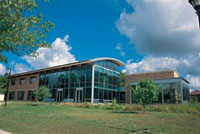“Do it in the dark!” That’s the rallying cry at Tufts University in Medford, Mass., where an ambitious campaign is under way to cut greenhouse gases.
Sure, climate change activism — conserving energy, using renewable fuels, and constructing eco-friendly buildings — isn’t as sexy as marching against Vietnam or burning bras. But in an increasingly warm world, working to reverse global climate change may be the next major social movement on American college campuses. While the U.S. government snubs the Kyoto Protocol on climate change, a small but growing number of colleges and universities are weaning themselves from carbon and adopting new attitudes about energy.
While the U.S. government snubs the Kyoto Protocol on climate change, a small but growing number of colleges and universities are weaning themselves from carbon and adopting new attitudes about energy.
“If you look at social movements in this country, they’ve never been led by government,” says William Moomaw, senior director of the Tufts Institute of the Environment and a professor of international environmental policy. “It was true of slavery, the women’s vote, civil rights, the Vietnam War. I think it will be true of addressing climate change.”
A recent survey by the National Wildlife Federation found that 80 percent of American colleges are trying to conserve energy, and half have developed efficiency codes. Nearly a quarter use some form of renewable energy, and 12 percent power at least some of their vehicles with alternative fuel.

Tufts love: a Toyota Prius on campus.
Photo: Tufts Climate Initiative.
Some of the change is coming from the top. Both the president of Tufts and a senior vice president at Cornell University in Ithaca, N.Y., have pledged to slice carbon emissions by 7 percent below 1990 levels by 2012 — the goal established for the U.S. by Kyoto. And a consortium of all 56 colleges and universities in New Jersey has promised to cut greenhouse gas releases by 3.5 percent below 1990 levels by 2005. In Pennsylvania, 25 campuses have pledged to collectively buy some green energy, including wind power, and to ultimately reduce their greenhouse gas emissions.
On other campuses, students are leading the charge. A student organization called Kyoto Now! is active at 36 schools, urging administrations to slash carbon releases in accordance with the Kyoto treaty. Undergraduates at Lewis & Clark College in Oregon overwhelmingly voted to increase student fees to raise the money for sufficient carbon credits to make the school Kyoto-compliant, without the support of the Board of Trustees.
At Oberlin College in Ohio, students and faculty will ask the Board of Trustees this fall to adopt a carbon-neutrality policy that would go far beyond Kyoto. The policy would commit the campus to powering itself without producing any carbon emissions by 2020, through buying green energy or producing its own. “Most of the conversation has been about being Kyoto-compliant, but everybody knows that will not solve the problems. It’s a very small bite out of a very big meal,” says David Orr, professor of environmental studies at Oberlin.
Demonstration Plots
While most colleges practice at least some energy conservation, only a small fraction of the nation’s schools have committed to major carbon reductions. “You have isolated champions around the country who are committed, and some are even [college] presidents, but not enough. There is not yet a critical mass,” says Wynn Calder, associate director of University Leaders for a Sustainable Future, a Washington, D.C., nonprofit that lobbies for progressive environmental policies in higher education.
But these pioneer institutions will eventually lead other schools down the same path, says Don Wheeler, past president of the New Jersey Higher Education Partnership for Sustainability. “Solar, wind, fuel cells, geothermal — those are all things campuses should be taking a lead on,” he says. “By turning our schools into demonstration cases, [the clean energy movement] will move forward.”

Not the conservatory: Oberlin’s
environmental studies building.
Photo: Oberlin College.
Oberlin exemplifies the practice of turning schools into demonstrations of clean energy: The school’s new environmental studies building is a model of green architecture and engineering. Because of its design, it uses one-sixth the energy of a conventional new classroom building. The solar complex currently generates 54 percent of the energy used in the building, and eventually will become a net exporter of electricity. The center opened in 2000, but is still, essentially, under construction, Orr says. “Our intention is to guide the building through a series of steps until it becomes radically efficient.”
Tufts, the University of Michigan, Lewis & Clark, and Stanford University are also planning to build new high-performance buildings and to green older dorms and classrooms. Other schools are taking smaller steps such as using only locally grown lumber for construction, which means gas-guzzling trucks don’t have to haul timber across the country.

Meanwhile, students in disciplines ranging from engineering and environmental science to architecture and economics are getting hands-on experience with these new building technologies. “We definitely have an interdisciplinary approach,” says Sarah Hammond Creighton, project manager of the Tufts Climate Initiative. “It’s not all about engineering. It’s about behavioral science, environmental policies, finance.”
Integrating practical questions about global warming into many different academic disciplines is one of the goals of the initiative. “If you’re going to teach economics, why not do a cost-benefit analysis on something interesting, like setting up different heating systems at the university or different ways of managing the grounds without so much machinery?” Moomaw asks. He says an interdisciplinary approach to climate change “can enhance the mission of the university, provide research opportunities, and even help the financial operations of the university.”
And energy conservation does save money. The State University of New York at Buffalo is saving an estimated $9 million annually because it has installed more efficient lighting and ventilation systems and is encouraging students and faculty to turn off their lights and computers. Those savings can help to offset more expensive green projects that may take longer to pay for themselves.
But getting students to care about global warming enough to change their behavior is one of the biggest challenges that universities face. A Gallup poll conducted in 2000 for the Institute for Global Ethics shows that while 80 percent of students believe the environment is already deteriorating, not nearly as many are active in the environmental movement. At Tufts, student “eco-representatives” try to get their classmates interested in conservation by holding “Do it in the dark!” contests and papering bathroom stalls with global warming trivia.
“For many, environmentalism is recycling your newspapers and cans. But when it comes time to buy that Ford Excursion, that resolve goes right out the door because people don’t think about it,” says Ted Shevlin, a Tufts eco-rep. “Getting people to consider the impacts of their actions is the most important, and most difficult, part of this job.”

